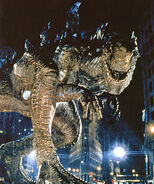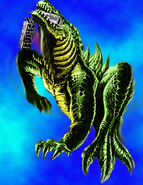Godzilla is a 1998 American science fiction giant monster film produced by TriStar Pictures, and the first American Godzilla film. The film was released to American theaters on May 19, 1998.
Plot[]
In June of 1968, a nuclear test is conducted in French Polynesia by the French government, exposing an iguana nest to the radioactive fallout.
Thirty years pass, and a Japanese cannery ship is attacked by a giant creature in the South Pacific, leaving only one survivor. The next evening, the surviving old man, now in a hospital and traumatized, is questioned by a Frenchman regarding what he had seen, to which he only responded "Gojira."
Dr. Nick Tatopoulos, a biologist working for the Nuclear Regulatory Commission, has been studying the effects of radiation on earthworms in the Chernobyl exclusion zone in Ukraine for 3 years. With the arrival of an official from the U.S. State Department however, Nick is reassigned and escorted to Panama by the military in order to examine the trail of destruction left behind by an unidentified animal, then to Jamaica to study the ruined ship on the shore. There, the Frenchman is also present, introducing himself as Philippe Roaché.
While aboard a military aircraft, Colonel Hicks is briefed about three ships being pulled under the waves. Hearing this, paleontologist Elsie Chapmanhypothesizes that the creature could be a descendant of theropod dinosaurs because of its size and the claw marks observed earlier. However, Nick disagrees, arguing that it would be much likelier for it to be a mutated creature spawned from the nuclear tests that took place in French Polynesia, near the area where it was first spotted.
Meanwhile, the monster arrives in New York City briefly and then disappears, forcing an evacuation. Nick, drawing parallels from his own research, notes that it might be easier to draw out the creature rather than force it in the open, and suggests a plan to lure out the creature out with fish. The plan ends up being successful as the creature comes up to Flatiron Square and begins feeding on the fish. However, as the military opens fire, it manages to evade all attacks and disappears. Following this, Nick collects a blood sample and examines it in his provisional military tent, finding out that the creature is pregnant and assumes that, since it's the first of its kind, that it must be capable of asexual reproduction. He shares this finding with his ex-girlfriend, Audrey Timmonds—an administrative assistant hoping to become a news reporter—following running into her after years of being separate. To confirm the finding definitively, Nick leaves. Looking around, Audrey discovers classified video tapes concerning the monster's origins. Deciding this is her best opportunity at becoming a news reporter, she takes them and films a report, turning it over to the media. When it airs however, she sees that her superior, Charles Caiman, declared it his own discovery and recorded over her segments, while mispronouncing "Gojira"'s name as "Godzilla."
Following the report's airing, Nick gets kicked off the team due to his apparent carlessness. After, he bids farewell to Audrey and then gets kidnapped by Philippe Roaché, an agent of the French secret service, who informs Nick that the U.S. government isn't interested in finding the theoretical nest, though the French ar.want to cover up any involvement they had with Godzilla's creation. Working with Nick, they begin looking for the nest somewhere within the city.
Surfacing once again, Godzilla escapes all of the military's attacks and dives into the Hudson River, where he is seemingly killed after colliding with torpedoes shot at him by nuclear submarines. Meanwhile, Roaché's team—secretly followed by Audrey and cameraman Victor "Animal" Palotti—search underground subway tunnels and enter Madison Square Garden, where they find over 200 eggs. Before they could begin destroying any, they begin hatching, and the babies proceed to pursue the human intruders because of the fish smell they carry. Nick, Audrey, Animal and Roaché hide in the stadium's broadcast booth and send a live news report. The military is made aware of the broadcast, and respond with an airstrike as the four barely escape before the arena is bombed.
Right then, Godzilla emerges from the garden's ruins, apparently having survived the torpedo attack in the river earlier. Seeing that all of his offspring are dead, he angrily chases down the group through the streets of Manhattan. After several close calls, the group lure Godzilla out into the open by driving through the Brooklyn Bridge, whose suspension cables trap the monster. Now helpless, Godzilla is hit directly by missiles from three F-18 Hornets and falls to the ground, dead. As the people of New York celebrate, Roaché says goodbye to Nick and others. Back in the ruins of the Garden, however, one egg remains, and then hatches.
Cast[]
- Matthew Broderick as Dr. Niko "Nick" Tatopoulos
- Jean Reno as Philippe Roaché
- Maria Pitillo as Audrey Timmonds
- Hank Azaria as Victor "Animal" Palotti
- Kevin Dunn as Col. Anthony Hicks
- Michael Lerner as Mayor Ebert
- Harry Shearer as Charles Caiman
- Arabella Field as Lucy Palotti
- Vicki Lewis as Dr. Elsie Chapman
- Lorry Goldman as Gene
- Doug Savant as Sgt. O'Neal
- Malcolm Danare as Dr. Mendel Craven
- Ralph Manza as Fisherman Joe
- Glenn Morshower as Kyle Terrington
- Chris Ellis as Gen. Hunter Anderson
- Richard Gant as Admiral Phelps
Monsters[]
- Godzilla
- Baby Godzilla
Marketing Campaign[]
The marketing campaign for Godzilla was multi-pronged in its execution:
Crushed cars were dotted around London as a part of a guerilla advertising campaign. In the month or so before its release, ads on street corners made references to Godzilla's size in comparison to whatever medium of advertising the advertisement was on.
Examples: "His foot is bigger than this bus", "His eye is bigger than this billboard", etc. Bits and pieces of different body parts of Godzilla were shown on TV commercials and posters, but never the entire body; this was to add a bit of mystery as to the design of the creature, ideally prompting people to see the film because that was the only way to see the whole creature. The same style of advertising is used for Steven Spielberg's adaption of War of the Worlds, where the alien attackers were rarely seen in advertisements and also for the movie Transformers where the Transformers are not fully seen. Unfortunately, the toyline was released before the film, and spoiled everything. Taco Bell had tie-ins such as cups and toys that promoted the film. The Taco Bell chihuahua was also at the height of its popularity in Taco Bell's television commercials. During the summer of 1998, several commercials pairing Godzilla with the Taco Bell mascot were produced and aired, including several with the chihuahua trying to catch Godzilla in a tiny box, whistling and calling, "Here, lizard, lizard, lizard." When Godzilla appears, the chihuahua says, "Uh-oh. I think I need a bigger box."
Scientific Errors[]
Errors that are scientifically and physically inaccurate:
- It would have been impossible for the Brooklyn Bridge to sustain Zilla's weight. It would have collapsed the moment he set foot on it.
- It would have been impossible for Zilla to have 200 eggs at the same time, because, taking into consideration their size in comparison to humans and Zilla's size, Zilla would need to have an enormous bulge showing an egg sac with all of those eggs, or at the very least have a huge decrease in hunger because of the hundreds of meters the eggs are occupying inside Zilla have to make Zilla lose appetite.
- On that note, iguanas do not lay anywhere near 200 eggs at one time. They lay, on average, about 50.
- The species that Zilla originated from, marine iguana, is only found in the Galápagos Islands, they do not exist in French Polynesia, the place where Zilla was mutated.
- More inaccuracies about Zilla being a marine iguana include that marine iguanas do not eat fish, they are not bipedal, and that they use their tails for defensive purposes (while Zilla used his mouth). While on the topic of Zilla's mouth, Zilla can completely destroy a helicopter with ease by biting it swiftly but cannot make any significant damage to a taxi that has been in his mouth for several seconds.
- When the Apaches are attacking Zilla in the city they say they are going to fire AIM-9 Sidewinders at it, but in real life sidwinders are Air-to-air missile that wouldn't have any effect on it and when they use their guns on Zilla they are shown to be next to the cockpit which is the wrong place on the design. The gun is mounted under the nose of the aircraft.
- In Zilla's first attack on New York, shortly after Zilla gets on a building to roar after destroying the Chrysler Building, Zilla disappears without trace and without anyone seeing or hearing him go away. This is physically impossible, considering Zilla's size and weight, plus the loud sounds he produces by walking.
- Marine Iguanas are mainly found by beaches and spend most of their time in the water. However, Zilla rarely goes in the water.
References[]
Though Zilla has no references in any cartoons (aside from the spin-off cartoon show), He has been referenced in the following Toho movies.
Godzilla 2000 - In the US Release, several of Zilla's roars were used in conjunction with Godzilla's new roars.
Godzilla, Mothra, and King Ghidorah: Giant Monsters All-Out Attack - Early in the film, people are discussing the history of Godzilla, and someone mentions that in 1998, Godzilla attacked New York. The Americans thought it was Godzilla, but the Japanese rightfully claim that it was an all together different monster.
Godzilla: Final Wars - Zilla makes a full appearance in Final Wars, attacking Sydney, Australia. The Actual Godzilla shows up and fights Zilla. Godzilla attacks him with his atomic breath, but Zilla dodges by jumping in the air. Godzilla counters by striking Zilla with his tail, sending Zilla into the Sydney Opera House and giving Godzilla a chance to use his atomic breath, which kills Zilla. The fight was the shortest in Godzilla history and one of the most famous since many fans enjoyed seeing Godzilla fight Zilla at that time.
Trivia[]
- Before Hank Azaria's character runs atop cars to get footage of Godzilla, he looks up and says "Aw jeez," using the voice of his character Moe Szyslak on The Simpsons (1989).
- Over 1,000 soft architectural pieces were created for falling debris.
- Godzilla wasn't supposed to have any breath weapon at all in this movie until an outraged fan poll demanded it.
- The extra killed in his car when Godzilla first arrives in Manhattan was cast as a look-alike for J.D. Lees, editor of G-Fan magazine, because he cast disparaging remarks about the information that leaked out about the film prior to its release.
- There was enough paint used on the film to paint the entire Golden Gate Bridge.
- The original plans called for two sequels to be produced. These plans were scrapped due to the poor reception of this film.
- This movie features more Simpson voice actors than any other project besides The Simpsons (1989) itself: Hank Azaria, Harry Shearer and Nancy Cartwright. The Simpsons and its creators are huge Godzilla fans and Godzilla, and his roar is used quite frequently in the show.
- Roland Emmerich admitted that he did not like the original Godzilla movies - he only agreed to the project after being promised to be able to do what ever he wanted with the series.
- Despite the less-than-expected box office performance, this film still made more money worldwide than any other American movie based on a foreign film.
Gallery[]
Videos[]

Godzilla 1998 Official Trailer






